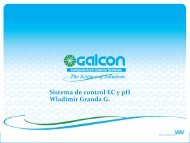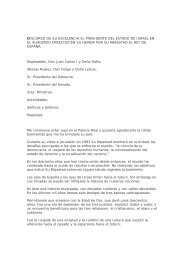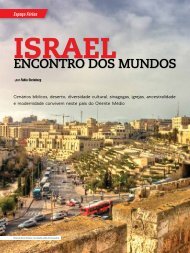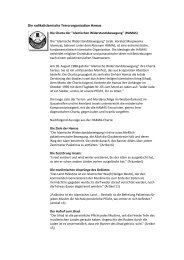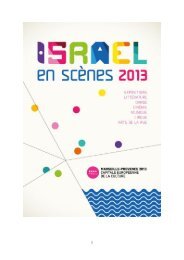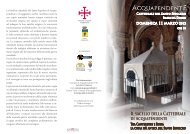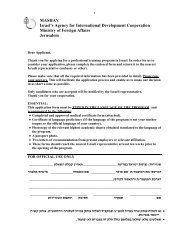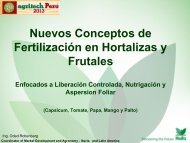Summary of the Verdict (TA 371/05) Estate of the Late Rachel Corrie ...
Summary of the Verdict (TA 371/05) Estate of the Late Rachel Corrie ...
Summary of the Verdict (TA 371/05) Estate of the Late Rachel Corrie ...
You also want an ePaper? Increase the reach of your titles
YUMPU automatically turns print PDFs into web optimized ePapers that Google loves.
h. The plaintiffs claimed that evidentiary damage was done in two areas:<br />
first, <strong>the</strong>y claim that <strong>the</strong> Criminal Investigations Division (CID)<br />
investigation carried out after <strong>the</strong> event was sloppy and unpr<strong>of</strong>essional<br />
and led to evidentiary damage for <strong>the</strong> plaintiffs; <strong>the</strong> second area, which<br />
refers to <strong>the</strong> responsibility <strong>of</strong> <strong>the</strong> Institute for Forensic Medicine for<br />
evidentiary damage caused to <strong>the</strong> plaintiffs as a result <strong>of</strong> <strong>the</strong> violation <strong>of</strong><br />
<strong>the</strong> judicial order and <strong>the</strong> destruction <strong>of</strong> <strong>the</strong> recording documenting <strong>the</strong><br />
decedent's autopsy.<br />
It could be expected that, in light <strong>of</strong> <strong>the</strong> claim made above, <strong>the</strong> plaintiffs'<br />
representative would submit to <strong>the</strong> court <strong>the</strong> file <strong>of</strong> <strong>the</strong> investigation<br />
conducted by <strong>the</strong> CID so that I could form my own opinion regarding <strong>the</strong><br />
investigatory actions carried out and <strong>the</strong> manner in which <strong>the</strong> investigation<br />
was carried out, and to learn if <strong>the</strong> actions taken by <strong>the</strong> CID were<br />
sufficient or not. However, it was <strong>the</strong> plaintiffs that objected to submitting<br />
<strong>the</strong> full file <strong>of</strong> <strong>the</strong> investigation as evidence, even though <strong>the</strong> defendant<br />
agreed to do so. Thus did <strong>the</strong> plaintiffs, by <strong>the</strong>ir own actions, introduce<br />
circumstances in which an extremely important tool to examine <strong>the</strong>ir<br />
claims was denied to <strong>the</strong> court.<br />
After examining <strong>the</strong> evidentiary material and studying <strong>the</strong> claims made by<br />
representatives <strong>of</strong> both sides, I reached <strong>the</strong> conclusion that <strong>the</strong> CID<br />
investigation was conducted appropriately and without fault.<br />
i. With regard to <strong>the</strong> claims made regarding evidentiary damages relating to<br />
<strong>the</strong> Institute <strong>of</strong> Forensic Medicine:<br />
Investigators from <strong>the</strong> CID concluded that in order to advance <strong>the</strong><br />
investigation, an autopsy would have to be performed on <strong>the</strong> decedent. As<br />
a result, <strong>the</strong>y approached <strong>the</strong> District Court in Rishon LeZion and asked<br />
for a court order that would allow for such an autopsy. The court order<br />
"…that <strong>the</strong> body be autopsied at <strong>the</strong> Abu Kabir Institute for Forensic<br />
Medicine by a doctor who is not in <strong>the</strong> military and in <strong>the</strong> presence <strong>of</strong><br />
a representative <strong>of</strong> <strong>the</strong> American State Department" (Exhibit 6/T).<br />
Pr<strong>of</strong>essor Hiss testified that since <strong>the</strong> American Consulate saw no need to<br />
send a representative to be present at <strong>the</strong> autopsy, <strong>the</strong> autopsy was<br />
conducted, with <strong>the</strong> family's agreement, without a consular<br />
representative. He also testified that <strong>the</strong> Consulate sent a fax confirming<br />
that <strong>the</strong> autopsy could be conducted without a representative from <strong>the</strong><br />
family (Exhibit 11/T).<br />
After examining <strong>the</strong> evidentiary material and studying <strong>the</strong> claims made by<br />
representatives <strong>of</strong> both sides, I reached <strong>the</strong> conclusion that <strong>the</strong> plaintiffs'<br />
claim <strong>of</strong> evidentiary damage by <strong>the</strong> Institute for Forensic Medicine<br />
seems strange. This is because <strong>the</strong> decedent's fa<strong>the</strong>r himself testified that,<br />
from <strong>the</strong> outset, <strong>the</strong> family had no intention <strong>of</strong> conducting an autopsy and<br />
that <strong>the</strong>ir intention was to pursue <strong>the</strong> matter diplomatically in order to<br />
clarify what happened to <strong>the</strong> decedent. Moreover: it appears that <strong>the</strong>



